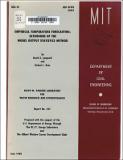| dc.contributor.author | Langseth, David E. | en_US |
| dc.contributor.author | Bras, Rafael L. | en_US |
| dc.date.accessioned | 2022-06-13T13:08:52Z | |
| dc.date.available | 2022-06-13T13:08:52Z | |
| dc.date.issued | 1980-06 | |
| dc.identifier | 257 | |
| dc.identifier.uri | https://hdl.handle.net/1721.1/143004 | |
| dc.description | Prepared with the support of the U.S. Dept. of Energy under Contract no. EX-76-A-01-2295 | en_US |
| dc.description.abstract | Deterministic models of complex natural phenomena such as streamflow or weather events are usually either unknown or unwieldy and thus are often augmented or replaced by stochastic or empirical models. For example, the National Weather Service (NWS) uses a combination of deterministic and empirical models to predict several weather parameters. An approximate deterministic model of the atmosphere provides predictions of some meteorological parameters at the grid points used in the numerical solution of the model. Some of these deterministic predictions, along with recent measured data, are then used as input variables to an empirical prediction equation. The National Weather Service uses a stepwise least-squares regression algorithm to develop the empirical equations. The prediction of maximum surface air temperature is investigated in this work. The NWS currently uses 10 variable linear models to predict maximum temperatures. The 10 variable restriction is based on research and the linear restriction is based primarily on the prohibitive amount of time and effort required to develop non linear models. The potential model improvements from relaxing these two restrictions are examined in this work. Data from Huntsville, Alabama, supplied by the NWS, is used. Non linear models are created by applying a non linear model identification algorithm called the Group Method of Data Handling to the data. Two linear model identification algorithms are also used. The usefulness of the removal of harmonic components and the identification of principal components were investigated along with each of the model identification algorithms. It is shown that, for the site investigated, the linear restriction does not hurt model quality and that while 10 is a reasonable number of variables, models with fewer variables can also perform well. Also, modeling the mean trends separately from the more transient effects improves model quality. | en_US |
| dc.publisher | Cambridge, Mass. : Massachusetts Institute of Technology, Dept. of Civil Engineering, Ralph M. Parsons Laboratory for Water Resources and Hydrodynamics | |
| dc.relation.ispartofseries | R (Massachusetts Institute of Technology. Department of Civil Engineering) ; 80-29. | |
| dc.relation.ispartofseries | Report (Ralph M. Parsons Laboratory for Water Resources and Hydrodynamics) ; 257. | |
| dc.title | Empirical Temperature Forecasting: Extensions of the Model Output Statistics Method | en_US |
| dc.identifier.oclc | 6842942 | |
| dc.identifier.aleph | 95198 | |
